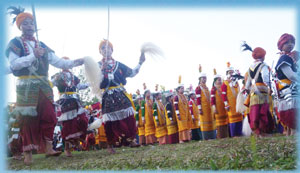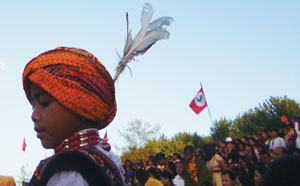Archives
THE SEASON OF FESTIVITIES
The land and its people comes alive in a joyous mood of dance and music, expressions of merriment, in a colourful fabric that weaves stories, since creation from the far recess of time. About the golden age and innocence, of how the Hynñiewtrep people descended to earth, ordained to be rulers of other creations, the plant and animal kingdoms, the vast natural resources, keeping in tune with the four seasons, while their nine huts-Khyndaitrep counter parts remain in their celestial abode.
This epic is depicted in the Chiphiah dance, of how the Hynñiewtrep, as a race travered the Golden Ladder (Jingkieng Ksiar), the pathway lit up by the seven colours of the rainbow, linking the galactic sphere – the divine abode above, - the skyway touching and ending at the crest of the sacred umbilical firmament peak (U Lum Sohpet Bneng). The Golden path Vine – is a philosophy of the origin and the relationship link of the Hynñiewtrep with the creator and the divine, which the umbilical firmament sacred peak testify, an affinity of a loving mother with her child through the umbilical cord. The Chiphiah dance in its religious form is performed at the annual pilgrimage, at the summit of the U Lum Sohpet Bneng, just beside the sanctum sanctorum, on the first Sunday of February. Otherwise the Chiphiah dance in its social significance is also called the Lahuh dance, specially in the Ri Pnar or Jaintia Hills, displaying the social matrilineal structure, of the role of that maternal uncle and of the father of a family clan. The cardinal virtue of the Chiphiah dance is that only virgins can take part in it. The accompanying song and traditional music of drums and flute, lend an air of festivity.
The Shad Suk Mynsiem – a dance of joyous heart and soul, is a splash of grandeur, heralding the spring season, an occasion of renewed hopes, paying obeisance and reverence to the Creator and the divine, the blessings that had been showered, soothing like spring showers, and invoking the Divine for health and prosperity, in which a bumper harvest of corn and paddy and other crops, would bring about contentment and happiness. It is a festival before seeds are sown in the fields and orchards.
The philosophy behind the splendor of Shad Suk Mynsiem, is the sowing not only of the seed grain, but also the seeds of knowledge, wisdom, moralistic values, conceptionalised in the ethical teachings of the forbears, that is to know oneself to be self soul searching, extending goodwill to others and being Divine conscious (Tipbriew Tipblei), to know and uphold ones relationship and bonds with the matrilineal and patrilineal clan system and order, right from the primodial ancestress and ancestor and maternal uncle, (Tipkur Tipkha), and to earn righteousness in one’s life time, (Kamai Ia Ka Hok).
This philosophical thought and teachings, is an insight to the future, a spiritual tradition, consciousness and awareness, pervading the human mind and natural surroundings, spanning the cosmos, in the path of truth and honesty and seeking contentment and being at peace with the Creator and the Divine powers, while on earth and in the afterlife. This leads to the harvesting of the bumper crop of not only the grain, but also the joy of happiness, in each hearth and home, so as to guard from evil influence and negative forces. The Shad Suk Mynsiem, is the envisaged and creativity efforts of the Seng Khasi organization, based on social and religio uplift, of traditional customs and practices. The Seng Khasi which was established on November 23rd in the year 1899 has now attained the maturity of being the custodian of the spiritual and cultural heritage of the Hynñiewtrep land and people. It was the sustained effort of the Seng Khasi, founded by sixteen visionary youth, to preserve the ancient Khasi dance form, performed in localized religious and social ceremonies, under one community platform, in the years, 1910 – 11, at the Weiking grounds Jaiaw, Shillong. Shad Suk Mynsiem festival is now celebrated in virtually almost all the nooks and corners of the Khasi Hills, throughout the spring season.
The Shad Suk Mynsiem, is the envisaged and creativity efforts of the Seng Khasi organization, based on social and religio uplift, of traditional customs and practices. The Seng Khasi which was established on November 23rd in the year 1899 has now attained the maturity of being the custodian of the spiritual and cultural heritage of the Hynñiewtrep land and people. It was the sustained effort of the Seng Khasi, founded by sixteen visionary youth, to preserve the ancient Khasi dance form, performed in localized religious and social ceremonies, under one community platform, in the years, 1910 – 11, at the Weiking grounds Jaiaw, Shillong. Shad Suk Mynsiem festival is now celebrated in virtually almost all the nooks and corners of the Khasi Hills, throughout the spring season.
The dancers both males and females are attired in gold and silver ornaments of vintage design. These gold and silver ornaments describe the precious inheritance of the Shad Suk Mynsiem, in all its meaning and significance. The silver crown on the virgin maidens head is attune to the honour and respect and position of the woman in society, that she is the keeper of not only her honour, but of the wider dimension of the Khasi race. In the crown, the feministic position, responsibilities are embedded, in the intrinsic designs. The Lasubon flower rising from the nape behind the crown, spread out the fragrance of sweet aromatic incense of purity, which should be the qualities characterizing womanhood.
One of the important ornaments of the males is the silver quiver with three arrows, one to defend oneself, the second – guarding the family and clan and the third protecting territorial rights of the state.
The dance form and pattern of the men holding whisps and swords circling the virgins in the inner circle, is the martial spirit in safeguarding not only the honour of the virgin, but also the wider perspective of shielding and protecting, the inherent philosophy behind the festivals.
The festivals during the freshness of the season, besides the Shad Suk Mynsiem, also the Shad Sukra of Ri Pnar in Jaintia Hills, the Shad Sajer Sathoh, Shad Lakympong in Ri Bhoi, is the strict adherence to the rule, that only the virgins can take part in the dances, implying the philosophy that amidst joy and merriment, the festivals carries the meaning and message of purity, sanctity and solemnity, being the spiritual essence in the celebrations, of thanksgiving.

